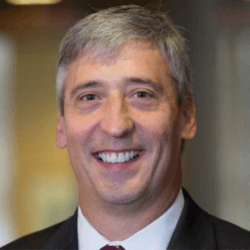September 29, 2020

The Future of Hospitals in Post-COVID America (Part 2): The Policy Response
Editor’s Note: This is our second article on the Future of Hospitals in Post-COVID America. The first article, published in July, examined the accelerating pace of industry consolidation and hospital rationalization. This follow-up article explores potential policy solutions for providing greater access to appropriate and affordable healthcare for residents in medically underserved communities.
Part 1: The Market Response
Part 2: The Policy Response
The Red Line in Chicago runs 23 miles north-south from Evanston through downtown into the South Side. In the prosperous Streeterville neighborhood served by Grand Station, a newborn baby has a life expectancy of 90 years. Ride a few stops south to low-income Englewood, and life expectancy drops 30 years.[1]
The Streeterville-Englewood life-expectancy gap is the nation’s largest within a single metropolitan area.[2] A complicated mix of societal and economic factors drives that disparity, but Chicago’s South Side is not unique. Adverse social determinants of health (SDoH) increase healthcare costs and diminish health and quality of life in hundreds if not thousands of American communities.

Listen to co-authors talk about the thinking behind this article on the House Calls Podcast available on iTunes & Spotify
Existing healthcare and social services fail to adequately address those challenges. The COVID-19 pandemic’s disproportionate impact on lower-income communities and the chronically ill makes social determinants even harder to ignore. Reorganizing US healthcare’s hospital-centric care delivery system will help drive better outcomes.
Bolstered by massive government funding under the CARES Act, many health systems around the country have managed to weather the first COVID wave. They now await a second wave expected fall 2020.
Hospitals serving affluent neighborhoods, like Streeterville, benefit from favorable payer mixes and strong balance sheets. Their futures seem secure. Some providers even view the current disruption as an opportunity to enhance their market positions, grow via mergers and acquisitions, expand their service offerings, accelerate digital adoption and transition to value-based care.
In contrast, hospitals serving less advantaged communities have fewer financial resources to support transformation and meet population health needs. Challenged by aging infrastructures, an adverse payer mix and distressed patient populations, these hospitals are closing at an accelerated rate, making access to appropriate care even more difficult for residents of those communities.
The worsening plight of these “safety net” and critical access hospitals makes more governmental funding and/or policy reform increasingly likely. As Cain Brothers’ Managing Director Carsten Beith noted in the podcast discussing our first article:
When you look at everything that COVID has brought to light in terms of disparities in care delivery and socioeconomic status, I think we’re going to see substantive changes in healthcare policy, reimbursement and delivery, and significant reallocation of healthcare resources to underserved communities.[3]
Beith’s co-author, Jim Moloney, concurred: “We’re on a very accelerated path toward a much bigger role for the government in our healthcare reimbursement models.”
This article explores how enlightened healthcare policies in concert with private sector investment and market forces can deliver higher quality, more affordable, and more consistently accessible care to lower-income communities.
When Market Forces Alone Aren’t Enough
When properly functioning, markets allocate resources to meet consumer needs efficiently and profitably. Unfortunately, some communities and regions lack market conditions conducive to enabling broad access to appropriate care.
On July 29th, 2020, Chicago’s Mercy Hospital and Medical Center announced it would close in early 2021.[4] Serving largely Medicaid and self-pay patients, Mercy loses $4 million monthly from operations and requires over $100 million in new capital investment. Its closure will further reduce care access for residents on Chicago’s South Side.

This is not a new phenomenon nor is it limited to inner-city hospitals. 120 rural hospitals have closed in the past 10 years,[5] including 18 in 2019. As Forbes Magazine noted in February 2020, “the regions with the highest number of rural hospital closures are some of the nation’s poorest and most vulnerable.”[6]
Urban and rural hospitals serving low-income communities confront existential environmental, fiscal and operational pressures that include the following.
Overreliance on centralized, hospital-based, acute care delivery. In medically underserved markets, patients have less access to services outside of centralized hospitals. Although a greater emphasis on primary, preventive, chronic, behavioral health, elder and home care would be optimal, traditional Fee-for-Service payment formularies tend to direct vital resources toward hospital-based acute care and higher-margin specialty services.
Older, sicker, more-costly populations. Patient populations with a higher prevalence of smoking, obesity, addiction, behavioral health issues and chronic disease strain costs and utilization. Social determinants, such as a lack of adequate housing and healthy food, make it almost impossible for area-hospitals to meet their residents’ comprehensive care and wellness needs. “Sickcare” prevails.
An adverse payer mix. Hospitals in low-income communities serve a higher percentage of patients through government-funded healthcare programs, primarily Medicare and Medicaid. This translates into lower treatment payments for equivalent procedures, since private health insurers pay nearly double Medicare rates for hospital-based services.[7] Notably, government programs pay significantly higher reimbursement rates for rural hospitals designated as critical access or sole community providers. A report by the Behavioral Science and Policy Association observed that hospitals serving a higher percentage of commercial-plan covered patients often have superior financial performance and better care outcomes. It concludes that payer mix correlates strongly with care quality.[8]
Lack of access to funding/capital. Hospitals in difficult markets often lack the financial strength to fund facility and technology upgrades as well as to reorganize services in ways that address broader community health needs. COVID-19 has exacerbated this predicament by reducing care volume and organizational cash flow.
Promising Approaches
Market forces work best where there are large patient populations, ample competition and well-paying clientele (including commercial insurance and Medicare). When markets are unable to organize services efficiently and effectively, governments can intervene to achieve desired outcomes through targeted interventions and appropriate regulatory measures.
Healthcare markets are regional and idiosyncratic. They defy one-size-fits-all policy solutions. Approaches to addressing fragmented delivery and social determinants must include a flexible mix of public, private and community-based efforts. The following examples illustrate a range of blended public-private solutions for medically underserved communities.

Regional Transformation Plans: Regional transformation plans align a broad array of stakeholders to deploy resources to achieve better care and health outcomes.
In 2018, not-for-profit health system Mission Health, based in Asheville, North Carolina, announced its sale to for-profit health system HCA. Sale proceeds funded the Dogwood Health Trust[9], the nation’s largest per-capita foundation,[10] which addresses issues related to social determinants of health in western North Carolina.
Beyond Mission, The North Carolina Department of Health and Human Services is also working informally with Blue Cross Blue Shield of North Carolina to incorporate payment formularies that emphasize preventive and primary care. Five of the largest health systems in the state are now operating under BCBS’s new capitated payment contract. As NC HHS Secretary, Dr. Mandy Cohen explains, “I want to buy health with our dollars, not necessarily buy health care.”[11]
Back in Illinois, a proposed merger of four struggling safety-net hospitals on Chicago’s South Side12 illustrates how urban transformation programs could work. Announced in January 2020, their publicly and privately funded plan envisions a reconfigured health organization with one or two hospitals, aligned community health centers, integrated health records, coordinated care delivery, and consumer-friendly digital access.
Enhanced Primary Care Programs: Changing payment models can improve care delivery and outcomes. Relying on risk-adjusted per member per month payments, a number of enhanced primary care companies have emerged to care for targeted populations largely through dual-eligible, Medicare Advantage and Medicaid managed care programs.
Such companies provide an array of services that enhance the quality of their care delivery by addressing social determinants. These include transportation, housing, nutrition, socialization and education services tailored to individual needs and preferences. Their twin goals are to keep their members healthy and provide timely appropriate treatment when necessary. To accomplish these goals, they employ integrated care teams, concierge-level services and digital technology platforms through convenient retail and virtual locations.
Notable enhanced primary care companies include Chicago-based Oak Street Health, Miami-based ChenMed, Atlanta-based AbsoluteCare, New York City-based Cityblock, Miami-based Cano Health and Boston-based Iora Health. Walgreens and VillageMD recently announced a partnership to open 700 primary care clinics around the country over the next 5 years.[13]
These are all well-funded, for-profit companies that are asset-light and poised for growth as payment models increasingly reward value-based care provision. Most are urban focused. Companies that offer enhanced and accessible primary and chronic care services in more rural markets include Bethesda-based Aledade, which is building a national network of physician-led ACOs, and Walmart, which is testing its own network of retail health clinics.
Global Budgets: Where the relative absence of market forces impedes the transition to value-based payment models, global budgets have shown promise in improving care quality and coordination while reducing overall costs.
Maryland’s Total Cost of Care (TCOC) program is a global budget solution for health systems that incentivizes cost containment and care coordination. Hospitals receive annual budgets based on historical volumes and operating costs, regardless of patient insurance. Launched statewide in 2014 as the Maryland All Payer-Model, the TCOC program achieved a 48% reduction in preventable complications, $429 million in hospital savings[14] and $679 million in total Medicare savings[15] by 2017.[16]
Similarly, the Pennsylvania Rural Health Model, initiated in 2017, also seeks to reduce costs, improve access and ensure quality for that state’s rural hospitals.[17] The program added 8 hospitals in 2020, bringing the total to 13, with payment coming from a combination of public and private payers.[18]
Conclusion: Taming Healthcare’s Gray Rhinos
The first article in this series began by discussing “Gray Rhinos,” the term author Michelle Wucker uses to describe highly probable, high-impact events that society chooses to ignore because the solutions are complex, inconvenient and fortified by perverse incentives that reinforce the status quo.[19]
US healthcare is replete with Gray Rhinos, its hospitals first among them. Many hospitals serving low-income rural and inner-city communities are failing despite a desperate need for appropriate, accessible and affordable healthcare services for local vulnerable populations. COVID-19 has only intensified the pressure these hospitals and communities face, heightening the urgency to address their financial and structural challenges.
Solutions must cater to local needs and preferences. Too often, reform efforts overlook regional nuances. Well-intentioned programs impose one-size-fits-all standards and processes that increase stakeholder burdens and frustrations.
American healthcare was already sick before COVID-19, but the pandemic’s impact has made health disparities more apparent. Clearly, the nation requires better balance between healthcare service delivery and public health, particularly in low-income communities. More of the same will continue to yield suboptimal health outcomes.
In South Africa’s Archbishop Desmond Tutu’s words: “There comes a point where we need to stop just pulling people out of the river. We need to go upstream and find out why they’re falling in.”
Any redesign of the American hospital system must go “upstream” to address the societal basis for bad health outcomes. Doing so will help revitalize the nation as it strives to emerge from one of the most difficult periods in its history.
Catch Up On Part 1
Any redesign of the American hospital system must go “upstream” to address the societal basis for bad health outcomes. Doing so will help revitalize the nation as it strives to emerge from one of the most difficult periods in its history. Click here to read it.
Want to know what healthcare executives are talking about this week? Subscribe to the 4sight Friday RoundUp on iTunes, Spotify, or where ever you listen to podcasts.
Sources
- https://www.economist.com/united-states/2019/10/10/a-ride-along-chicagos-red-line
- https://www.chicagotribune.com/business/ct-biz-chicago-has-largest-life-expectancy-gap-between-neighborhoods-20190605-story.html
- https://podcasts.apple.com/us/podcast/house-calls/id1483699530
- https://www.chicagotribune.com/opinion/commentary/ct-opinion-mercy-hospital-closing-south-side-transformation-20200810-ropmyknbyrgmjabg6xexjszzye-story.html
- https://www.forbes.com/sites/claryestes/2020/02/24/1-4-rural-hospitals-are-at-risk-of-closure-and-the-problem-is-getting-worse/#3758ad321bc0
- https://www.beckershospitalreview.com/finance/rural-hospital-closures-hit-record-high-in-2019-here-s-why.html
- https://www.kff.org/medicare/issue-brief/how-much-more-than-medicare-do-private-insurers-pay-a-review-of-the-literature/
- https://behavioralpolicy.org/wp-content/uploads/2017/02/BSP_vol1is1_Manary.pdf
- https://dogwoodhealthtrust.org/
- https://www.4sighthealth.com/mission-first-mission-healths-surprising-sale-to-hca/
- https://www.nytimes.com/2019/08/26/business/north-carolina-health-care-outcomes-html
- https://chicago.suntimes.com/business/2020/1/23/21077674/hospital-merger-south-side-advocate-trinity-south-shore-mercy-hospital-st-bernard
- https://www.healthcaredive.com/news/walgreens-invests-1b-in-primary-care-clinics-with-villagemd-deal/581208/
- https://www.commonwealthfund.org/publications/fund-reports/2017/aug/emerging-approach-payment-reform-all-payer-global-budgets-large
- https://www.healthaffairs.org/do/10.1377/hblog20180508.819968/full/
- https://www.google.com/url?sa=D&q=https://www.modernhealthcare.com/opinion-editorial/global-budgets-offer-financial-cushion-amid-coronavirus-pandemic&ust=1601492220000000&usg=AOvVaw21cUT2JmQFXWCFPT2reFLX&hl=en&source=gmail
- https://innovation.cms.gov/innovation-models/pa-rural-health-model
- https://www.google.com/url?sa=D&q=https://www.hcinnovationgroup.com/policy-value-based-care/alternative-payment-models/news/21120083/&ust=1601492220000000&usg=AOvVaw1d-8EKVV05d5HxqmXsddgp&hl=en&source=gmail
- The Gray Rhino: How to Recognize and Act on the Obvious Dangers We Ignore by Michelle Wucker
Authors
 David Morlock is a senior banker in the Firm’s Health Systems M&A Group. Mr. Morlock joined Cain Brothers in 2016 with 30 years of experience as a health system executive. His track record includes strategy development, mergers and acquisitions, affiliation agreements, joint ventures, major capital investments, and other unique arrangements tailored to meet the needs of healthcare organizations’ specific circumstances. Notable and innovative transactions and advisory engagements include the divestiture of MDwise health plan by Indiana University Health, acquisition of Ohio Valley Health by Alecto, affiliation between Fairview Health and the University of Minnesota, healthcare strategic advisory work for the University of North Carolina, affiliation between ProMedica and the University of Toledo College of Medicine, the University of Michigan Health System sale of M-Care to Blue Cross Blue Shield of Michigan, and the University of Michigan’s acquisition of a major research campus from Pfizer. Mr. Morlock is a frequent author of articles and speaker on health care industry mergers and acquisitions and strategic capital insights.
David Morlock is a senior banker in the Firm’s Health Systems M&A Group. Mr. Morlock joined Cain Brothers in 2016 with 30 years of experience as a health system executive. His track record includes strategy development, mergers and acquisitions, affiliation agreements, joint ventures, major capital investments, and other unique arrangements tailored to meet the needs of healthcare organizations’ specific circumstances. Notable and innovative transactions and advisory engagements include the divestiture of MDwise health plan by Indiana University Health, acquisition of Ohio Valley Health by Alecto, affiliation between Fairview Health and the University of Minnesota, healthcare strategic advisory work for the University of North Carolina, affiliation between ProMedica and the University of Toledo College of Medicine, the University of Michigan Health System sale of M-Care to Blue Cross Blue Shield of Michigan, and the University of Michigan’s acquisition of a major research campus from Pfizer. Mr. Morlock is a frequent author of articles and speaker on health care industry mergers and acquisitions and strategic capital insights.
David Morlock is a senior banker in the Firm’s Health Systems M&A Group. Mr. Morlock joined Cain Brothers in 2016 with 30 years of experience as a health system executive. His track record includes strategy development, mergers and acquisitions, affiliation agreements, joint ventures, major capital investments, and other unique arrangements tailored to meet the needs of healthcare organizations’ specific circumstances. Notable and innovative transactions and advisory engagements include the divestiture of MDwise health plan by Indiana University Health, acquisition of Ohio Valley Health by Alecto, affiliation between Fairview Health and the University of Minnesota, healthcare strategic advisory work for the University of North Carolina, affiliation between ProMedica and the University of Toledo College of Medicine, the University of Michigan Health System sale of M-Care to Blue Cross Blue Shield of Michigan, and the University of Michigan’s acquisition of a major research campus from Pfizer. Mr. Morlock is a frequent author of articles and speaker on health care industry mergers and acquisitions and strategic capital insights.
 Bart Plank is the Co-Head of Healthcare Public Finance at Cain Brothers, a division of KeyBanc Capital Markets. In addition to management responsibilities, Mr. Plank serves as a lead banker on all manner of financing transactions related to hospitals and post-acute care providers. Prior to Key’s acquisition of Cain Brothers, Mr. Plank served as a member of the Cain Brothers’ Executive Committee and Commitment Committee.
Bart Plank is the Co-Head of Healthcare Public Finance at Cain Brothers, a division of KeyBanc Capital Markets. In addition to management responsibilities, Mr. Plank serves as a lead banker on all manner of financing transactions related to hospitals and post-acute care providers. Prior to Key’s acquisition of Cain Brothers, Mr. Plank served as a member of the Cain Brothers’ Executive Committee and Commitment Committee.
Mr. Plank joined Cain Brothers in 1997 and has over 23 years’ experience advising tax-exempt healthcare borrowers in capital raising transactions. Mr. Plank’s notable transactions include: advising Oklahoma University of Medicine on over $2 billion of bridge loan and permanent financing related to its purchase of a joint venture interest from HCA and related capital projects, advising MaineHealth on financing and swap transactions in excess of $1 billion, serving as lead banker on Prime Healthcare Foundation’s inaugural $275 million public bond offering, and serving as underwriter on approximately $5 billion of tax-exempt healthcare bond issuance from 2010 to 2017. Prior to his underwriting role at Cain Brothers, Mr. Plank spent several years advising tax-exempt healthcare entities on several billion dollars in notional amount of derivative transactions.
Prior to joining Cain Brothers, Mr. Plank was an Analyst at Dillon Read in that firm’s Public Finance Group, where he focused on supporting tax-exempt and taxable financings for large municipal borrowers. Mr. Plank earned a BA in Economics from Middlebury College.





